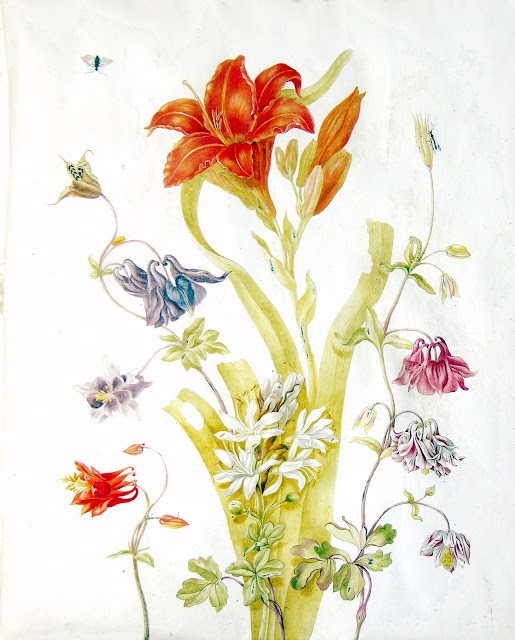Natural History Offering of the Day: Original Watercolor by Graffe
AN ORIGINAL WATERCOLOR BY JOHANNA HELENA GRAFFE
Maria Sibylla Merian (1647-1717)
Lily Still Life
15” x 11 1/4”; Framed: 20 1/2” x 23 3/8”
Watercolor and pencil on vellum
$75,000
Lily Still Life
15” x 11 1/4”; Framed: 20 1/2” x 23 3/8”
Watercolor and pencil on vellum
$75,000
The paintings by Maria Sibylla Merian reflect the typical combination of objects found in a cabinet of curiosities. Eager to acquire the latest discoveries, wealthy collectors employed artists to record their rare cabinet collections. In all but one of the Merian works here offered, the tulip is placed at the center of the arrangement, reflecting its relative rarity and high value during the seventeenth century. Indeed, the demand for tulips reached such a height that they became prized items in collections of exotic treasures. The 'broken' flowers, here pictured, were more highly prized than the plain-colored and yet out of one thousand only one or two would appear 'feathered' or 'flamed'. The secret of how this happened was not fully understood until the 1920s when it was discovered that a virus caused the change.Merian not only concentrated upon the beauty of flowers but in the majority of her compositions included insects, an unusual consideration for a woman of the seventeenth century. In her publication, Metamorphosis Insectorum Surinamensium, Maria Sibylla Merian was to confess: "From my youth onward I have been concerned with the study of insects. I began with silkworms in my native city, Frankfurt am Main; then I observed the far more beautiful butterflies and moths that developed from other kinds of caterpillars." Maria Sibylla was born in Frankfurt, Germany on April 2, 1647 to the famous publisher, Matthias Merian (1593-1650), and his second wife, Johanna Sibylla Heim. At the age of three her father died and one year later her mother married the Dutch painter, Jacob Marrell (1613-1681), also a resident of Frankfurt. He provided her with an early artistic training and introduced her to natural history illustration. At the age of eighteen Maria Sibylla married Johann Graffe, a former apprentice of her stepfather, and moved to Nuremberg. She gave birth to two daughters, Johanna Helena and Dorothea Maria, and during this time painted watercolors on vellum for sale. Apart from the work of her stepfather, Merian was also acquainted with the work of other painters, such as Nicolas Robert (1614-1685), painter to the French Crown and a significant contributor to the Velins du Roi. As can be seen in the spectacular watercolors here presented, her skill was immeasurable and in execution somewhat influenced by the work of not only her stepfather but also Robert. In 1685, Maria Sibylla left her husband and with her daughters and mother joined a spiritual community established by the Labadist sect. After five years, she withdrew from the commune and moved to Amsterdam. Fourteen years later she embarked, with her daughter Dorothea, upon a voyage to Surinam (now Guyana) to record the natural life of the Dutch colony.
Arader Galleries intends to have the lowest prices on ABE, Alibris, Biblio, AE, and Artnet while maintaining the highest levels of quality in the business for every offering. To inquire or view the complete offering, please contact our curators at info@aradernyc.com or call our 72nd Street NYC gallery at (212) 628-3668.



Comments
Post a Comment